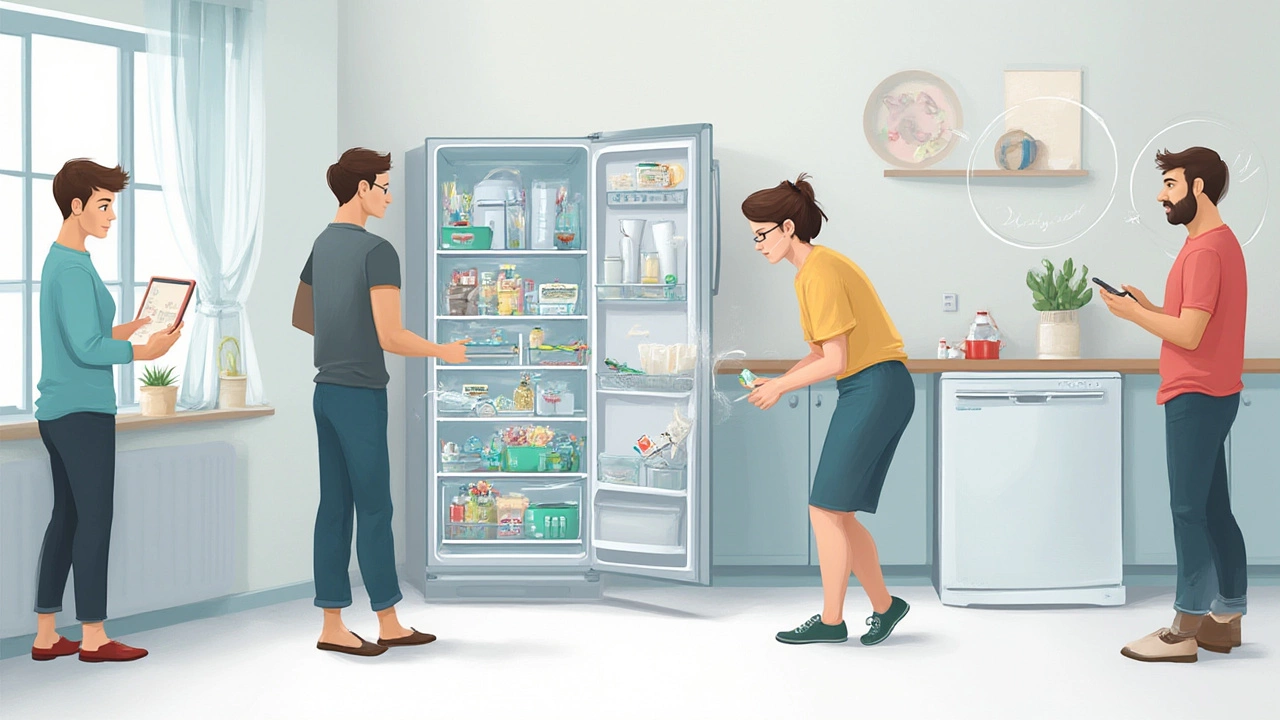It's wild how we count on our appliances every single day, yet most of us couldn't say exactly what happens inside them when we hit the power button. Whether it's the washing machine humming in the corner, the oven preheating for your dinner, or the fridge keeping the milk cold, these gadgets quietly get the job done with a sort of mechanical magic. But peek underneath the surface, and it’s a symphony of parts working together, not just blind luck. Knowing how your appliances work can save time, money, and sometimes a little dignity when something suddenly grinds to a halt.
The Beating Heart of Your Home: What Makes an Appliance Tick?
Think of each appliance as a team of specialists jammed into a box, each with a precise job. Take a washing machine, for instance. It starts with the control module—that’s the little brain often behind the dials or touchscreen. When you press ‘start,’ sensors check the lid is closed (so you don’t end up with a soap fountain on the floor). Next, the water inlet valves open, letting the right amount of water fill the drum. Did you know the average British family loads their washer 260 times a year, according to the Energy Saving Trust? That’s a lot of mechanical action.
Once the water’s in, the heating element quietly increases the temperature, monitored by thermostats. Detergent gets pulled into the mix through a simple siphon, and an electric motor spins the drum one way, then the other. These motors run on AC or DC power, with brushless models now more common—they last longer and make less noise. During the rinse, fresh water whooshes in, and a powerful pump ejects the spent, sudsy liquid down the drain.
And what about fridges? Most work using a refrigeration cycle. The compressor (the buzzy box at the back) squashes refrigerant gas so it heats up, then forces it through a condenser coil to cool it down. When the now-liquid refrigerant passes through a tiny expansion valve, it quickly cools and evaporates inside the coil lining your fridge's interior, drawing heat out of the compartment. That’s why food stays cold even if the kitchen heats up. Modern fridges now use smart sensors to monitor internal temps, tweaking compressor activity to use less power—especially useful, since a fridge typically eats up around 13% of household electricity every year in the UK.
Ovens and hobs might seem simple—they just get hot, right? But inside, it’s all about precise control. Electric ovens use a series of resistance coils that heat up when current passes through, while fan ovens add a motor-driven fan for even heat distribution. Gas cookers rely on a valve and igniter working together—a spark or tiny electric filament lights the gas, while thermocouples cut the supply if they sense the flame's gone out (a clever safety detail that's saved countless kitchens).
All these devices rely on a tight web of sensors, timers, relays, switches, and actuators. Even something basic like a tumble dryer throws in moisture sensors that judge when laundry is actually dry, switching off to avoid wasted energy and overdrying your favourite shirts. If you're ever tempted to try a repair, watch out for stored electricity—even unplugged appliances can hold a dangerous charge in their capacitors.
Getting Hands-On: Basic Functions and Their Hidden Details
If you’re the kind of person who likes to fix things or just wants to know why the dishwasher keeps beeping, understanding the basics can make life way easier. Start with control systems—they're usually circuit boards packed with tiny components, and if one goes bad, it can cause wild symptoms like flashing lights, no response, or stuck programs. Loads of faults trace back to a dodgy sensor, stuck relay, or burnt out resistor. Spotting a burnt smell or ‘popped’ capacitor? That's usually a tell-tale sign your control board needs a closer look.
Let’s take a common scenario: your washing machine won’t spin. Could be the lid switch (those things wear out), a broken drive belt, or a jammed motor. Or maybe the water’s not draining—often that's a clogged filter or blocked pump impeller. You’d be surprised how many odd socks and coins make their way down there, jamming things up. For a quick check, manufacturers usually add an access panel at the front, so you can reach the filter. Don’t forget: always unplug before poking around.
Dishwashers are no less complex. There’s a pressure sensor that tells the machine when it’s full enough; ignore an error code for too long and you risk a watery mess. Plus, the heating element doesn’t just clean—it also has to dry dishes, so if cutlery's coming out wet, this is the first thing to test. Pro tip: granite or plastic plates don’t dry as well since they cool off faster than ceramics, which means less evaporation.
Microwaves work by agitating water molecules with high-frequency electromagnetic waves (around 2.45 gigahertz). Unlike ovens, microwaves don’t really ‘cook’ the outside—energy is soaked up by water, fats, and sugars inside the food, which is why your pizza sometimes comes out hot in the middle but still cold on the edge. The core of the system is a magnetron, and if it breaks down, repairs are best left to professionals—capable of holding a severe shock even unplugged. It's worth noting: modern microwaves use turntables and mode stirrers to cut down on hot spots. And if the door seal is damaged, stop using the machine; it’s the only line between you and leakage of those waves.
Sometimes it’s just the tiny things that break—a fractured door latch on a tumble dryer, a blocked spray arm in a dishwasher, or a seized fan in an oven. Many parts now come as easy-swaps, so a little research and a YouTube guide can save a tonne of money.

Inside the Circuitry: Smart Features and Advanced Technology
New appliances aren’t just boxes with heaters and motors anymore—they’re crammed with smart features. WiFi-connected machines can start a wash or preheat the oven via your phone. Some fridges even have cameras inside so you can check if you’re out of milk while at the supermarket. All this is driven by microcontrollers, firmware, and, in high-end gadgets, machine learning software that could soon predict when maintenance is needed or how to use less electricity based on your habits.
Take washing machines with auto-dose systems. These scan how dirty your clothes are, weigh the load, and release just the right amount of detergent—saving cash and the environment. Fridges may now adjust humidity zones for veggies, while some ovens use temperature probes to get roast chicken exactly right. The sensors in these devices have become shockingly accurate; for example, British brand Beko introduced models that estimate load size and adjust cycle time and water usage, often shaving 40% off regular energy consumption.
There’s a catch, though: more complexity can mean more things to go wrong, especially with software glitches. It’s not rare for a perfectly functional heating element to sit idle if a bug freezes the control board. Over-the-air software updates—common in smart homes—fix bugs but can also brick a device if interrupted. Top tip: if you’re offered a factory reset or reboot, give it a try before calling out an engineer; it often clears up unexplained faults.
Security is a hot topic, too. Recent research from Which? found over half of connected home devices have weak default passwords, and some could be vulnerable to hackers. Change your passwords, install updates, and use your phone only on your home WiFi—not public hotspots—when controlling your appliances.
The upside is that today’s machines are far more energy-efficient than their ancestors. According to a 2024 DEFRA survey, modern dishwashers now clean a full load using less than 10 litres of water, while a hand-wash can use up to 50 litres. Look for the energy label, usually A++ or A+++ for top efficiency. Combining this with scheduled running (using smart plugs or internal timers) helps dodge peak electricity tariffs and saves over £100 a year on energy bills for a typical UK household.
Keeping It Running: Maintenance and Troubleshooting Tricks
Here’s the thing—appliances last longer if you keep them clean and watch out for little problems before they become big headaches. Start with door seals on washing machines and fridges. Wipe them weekly to stop mold and keep out crumbs. A 2023 study by Bosch found nearly 20% of washing machine breakdowns happen because people forget to clean the filter, letting grit build up and strain the pump. Simple check: once a month, open the access port and clear out any fuzz and coins.
Descaling kettles, dishwashers, and washing machines is a must if you live in a hard water area—like Bristol—where limescale builds up fast. Manufacturers often suggest a monthly or quarterly schedule. Vinegar or specialist descaler works well. It keeps heating elements efficient, cuts running time, and shaves pounds off your electricity bill.
Don’t ignore weird noises—they’re the first clue. A banging washing machine may have an unbalanced load, worn bearings, or broken suspension springs. A buzzing fridge could signal a dirty condenser coil, easily cleaned with a long brush. Modern ovens need their fans kept dust-free, and dishwashers with grimy spray arms can be popped out and rinsed under the tap. Here’s a handy table showing how long key parts usually last and when to give them a quick check:
| Appliance Part | Average Lifespan (Years) | Check Frequency |
|---|---|---|
| Washing Machine Door Seal | 4-6 | Wipe weekly |
| Oven Heating Element | 5-8 | Inspect every 6 months |
| Fridge Compressor | 10-15 | Clean coils yearly |
| Dishwasher Spray Arm | 5-7 | Rinse monthly |
| Microwave Magnetron | 7-10 | Call pro if not heating |
Troubleshooting is mostly about spotting patterns. If your machine trips the electricity every time it spins, check for water leaks or a worn heater. If the gas hob’s failing to light, look for a clogged burner or a weak igniter battery. And if you smell burning plastic, stop using the appliance straight away—it’s a classic sign of loose connections or cooked wiring inside.
Finally, keep the user manual handy (or stored as a PDF on your phone). It’s packed with part numbers, error code explanations, and specific tips for your model—sometimes it’ll save you hours of guesswork. And remember: safety first. If in doubt, unplug and call a professional.

When to Call An Expert (And How to Save On Repairs)
Even the bravest DIYer hits a wall eventually. If you’re dealing with gas, high-voltage circuits, or sealed systems (like fridge compressors or microwave magnetrons), that’s your cue to book a qualified repair technician. The Gas Safe Register, launched back in 2009 after replacing CORGI, lists everyone legally allowed to work on gas appliances in the UK.
For electrical repairs, look for engineers approved by the NICEIC or registered with a trade group like REFCOM for refrigeration. You’ll often get a guarantee on their work, and it could protect your household insurance if the worst happens. Many brands now offer fixed-fee repairs, so ask upfront about costs, and check the appliance’s warranty—you’d be surprised how often parts are still covered after a few years, especially if there’s a known fault or safety recall.
Want to save cash? Keep receipts, register your appliances for free warranty extensions, and join local Facebook groups or repair cafes. Loads of small faults—like worn door switches, clogged hoses, or cracked knobs—can be tackled with the right part and a bit of patience. A study by Cardiff University in 2024 found that 64% of home appliance repairs involved simple parts costing less than £25. Plenty of YouTube channels walk through most fixes step by step (check the comment section for extra tips or warnings).
If you’re stuck waiting for a pro, or need to keep things ticking over, there are a few rescue hacks:
- Don’t overload machines. It wears parts faster and causes vibration faults.
- Running a high-temperature wash (with no clothes) every few weeks keeps bacteria and mould at bay in your washing machine.
- Clean dryer lint traps after every use—not just for efficiency, but to avoid house fires.
- Use surge protectors for electronics-prone appliances like microwave ovens or fridges during thunderstorms.
- Snap a pic of any error code. It helps when searching forums or talking to support staff.
If there’s one secret, it’s this: the more you understand how an appliance function works, the easier it gets to spot problems, avoid rookie mistakes, and keep things running without drama. These machines might seem mysterious, but once you get under the bonnet, you’ll see they’re just clever combinations of straightforward parts, all working together to make everyday life a little smoother.




